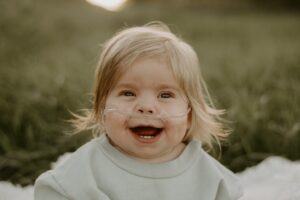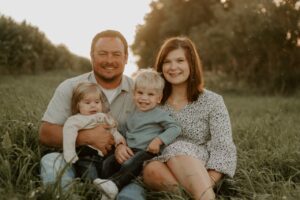When Arica Svoboda thinks of her two children, Hayes and Hendrix, she can’t help but fill up with love. She tells Patient Worthy:
“My boys are special. Their smiles and personalities light up a room.”
Despite their joyful and effervescent personalities, both boys face a challenge that few people in the world can conceive of. They are two of just seven people globally who have been diagnosed with the ultra-rare mitochondrial disease SLC25A26. While Hayes faces a more severe disease, Arica says:
“Nobody would ever guess that anything is off with Hendrix. But when you look closer, you see that he can’t walk as far as other kids. He just learned how to run. He gets out of breath easily. People judge very easily on outward views, but there are so many people living with diseases that are silently killing them and taking control of their lives. I want to share my children’s story to raise awareness, to let other families know what to look for, and to bring to light these topics that we don’t always speak about.”

Recently, Arica and I sat down to discuss the diagnostic journey for Hayes and Hendrix, how the boys are managing today, and the challenges of living with and trying to manage an ultra-rare disease.
The Diagnostic Journey
When Arica was pregnant with her first son Hendrix, everything seemed to be going well. It wasn’t until Hendrix was born that some potential problems began to arise. After birth, the hospital performs a newborn screening panel. This includes pulse oximetry, which searches for congenital heart defects or other heart issues. Hendrix failed his first heart screening. The hospital sent him home with Arica and her husband, scheduling a follow-up echocardiogram a few weeks later. Unfortunately, this echocardiogram still showed very high pressures in his pulmonary arteries.
As a result, the Melheim family ended up traveling to Colorado for further testing. After spending one month in Colorado, the family found out that Hendrix had pulmonary hypertension. This led to further testing to determine if it was persistent pulmonary hypertension in a newborn or if it was something else. Eventually, the doctors told the family that it was persistent pulmonary hypertension in newborns, PPHN and that Hendrix would grow out of it. Armed with oxygen and medication, the Melheim family traveled home.

But within months, Hendrix started showing other health concerns. Says Arica:
“At nine months old, he was hospitalized for a Heart Catheter. We decided to complete some additional genetic testing. But that showed that nothing was wrong. So at the time, we figured that we had done all we could to learn what was happening.”
Hayes and the Search for a More Concrete Diagnosis
Later, Arica learned that she was pregnant with her second son, Hayes. Her pregnancy and labor both went smoothly. But within twelve hours following Hayes’ birth, he began showing more severe symptoms than his brother did. Arica shares that the family started Hayes on oxygen and medication way earlier to try to mitigate any negative health impacts.

Eventually, Arica and her husband decided to do whole exome sequencing on both of their children. She shares:
“For Hendrix, we had two potential things come back. One was Cornelia de Lange syndrome, but that was recessive, so we knew that wasn’t it. The other was an unknown mitochondrial issue, but doctors couldn’t give us much information because they said there wasn’t enough research on it. Hayes had the same unnamed mitochondrial mutation, which was SLC25A26.”
To this day, there are only seven known cases of SLC25A26 in the world; Arica’s sons are two of these. Unfortunately, three of the other five died in early childhood. The remaining two adult patients are explored in this research, published in Human Molecular Genetics. Arica says:
“As of now, we haven’t been able to get much education or information about SLC25A26. In other patients, high lactic acid levels have been life-threatening. We haven’t had this problem with the boys yet, but are trying to stay vigilant in case that happens. In a few years, we want to redo whole exome sequencing for Hayes to see if we can learn more. Otherwise, there has been no new research or information.”
SLC25A26 Management
Currently, Hendrix is three years old and continues to show off how strong he is. He is on triple therapy for his pulmonary hypertension, but will be coming off of his third one by Valentine’s Day if all goes to plan. Arica explains:
“Of course, insurance did not approve the oral version of his medication. I know all too well that insurance can be terrible with rare diseases. But Hendrix should be going down to two medications for his pulmonary hypertension and he’s also on triple therapy for his mitochondrial disease to maximize support. Other than that, he’s been growing and hitting his developmental milestones in ideal time frames. So he’s easier to manage at home.”
Alternately, Hayes is experiencing much more severe symptoms. On February 6, Hayes turned 18 months old. He has spent over 317 total days in the hospital since he was born. His family has consulted with Colorado Children’s Hospital, Texas Children’s Hospital, MHealth, St. Louis, Wisconsin Children’s and more. Arica explains:
“Hayes’ journey has blended geneticists and pulmonologists and cardiologists to figure him out and keep him safe. That is one thing that I’ve learned is that it’s more important to keep him safe than anything else and it’s not the easiest. It’s hard to explain how rare he is to friends and family. How rare both the boys are, really. They’re both tube-fed and they both require a lot of oversight. We’re trying to figure out the best life for these children.”

Hayes is still very weak; he sometimes has to be intubated for a cold. Recently, Hayes was denied a lung transplant because of his mitochondrial mutation. While he was approved for a Reverse Potts Shunt in St. Louis, he is not yet stable enough for the surgery. Arica says:
“The shunt is to prolong his time before he can get the lung transplant, which we hope we can get approval for in the future. We’re stuck in a spot where we’re questioning whether to keep interfering or just focus on his quality of life. I just want to make the decision ourselves. When you’re a parent, you go home and choose how you feed your child, when their bedtime is, who they get to meet. Our choices have been taken away from us and put in the hands of doctors and insurance. I don’t know what their future is or where it’s going to go, but I want to make a decision and a difference that will help my children.”
Currently, one of the most challenging parts of caring for Hayes and Hendrix is that they both have as much access to their parents as they can even though they are in different states. Arica and her husband rotate who is in the hospital and who is at home. They find time to speak with each other. It is difficult and sometimes hard to do, but Arica wants each child to know that they are loved.
Arica is looking for other families whose children might have SLC25A26. If you know someone who may have a similar condition and wants to connect, please reach out.






